★★★
“Text and Violence.”
“The challenge…is to find a middle ground between cinematic enjoyment and cultural critique.”
 The above quote, from one essay in this collection of pieces on “violent women in the movies”, perhaps sums up its main problem. I cheerfully admit that my writing is skewed heavily towards the former point of view, but even so, too many of the authors here seem concerned with squeezing meanings out of films that were never intended to be there. This over-analytical approach results in the book swinging between thought-provoking and infuriating on almost every page.
The above quote, from one essay in this collection of pieces on “violent women in the movies”, perhaps sums up its main problem. I cheerfully admit that my writing is skewed heavily towards the former point of view, but even so, too many of the authors here seem concerned with squeezing meanings out of films that were never intended to be there. This over-analytical approach results in the book swinging between thought-provoking and infuriating on almost every page.
My opinion is that truth and the movies are almost mutually exclusive. Reality is rarely cinematic, and is likely to be an early casualty – see any “true story” for an example of how facts are modified and sacrificed in the name of art. Cinema is thus no more an accurate mirror of society, than it is any other area. An alien trying to learn history, say, from Hollywood, would believe America defeated Hitler single-handed, before going on to glorious victory in Vietnam.
Nor do I feel that movies influence society. The editors suggest that female action heroines are a self-defence tool, in that they might make men think twice about attacking a woman for fear of retaliation. It’s an interesting idea, but how many rapists went to see Enough? And even if they did, the result might be more violence, in order to pre-empt a response. The net impact, however, is likely to be negligible.
There is also an assumption in several places that all violent women are male fantasies, which – for about the only time in the book! – is over-simplistic. The concept of heroes and villain is non-gender specific, and no violent woman could come to the screen without the explicit collusion of at least one female, the actress playing her. Not that this satisfies some contributors, who seem unhappy whether a heroine shows feminine attributes (cliched weakness!) or not (she’s just a man in drag!).
It’d be unfair to cover such a disparate collection with one review, so I’d like to cover each article separately, albeit not in as much depth as some of them deserve. If you just want a quick overview, feel free to skip the section between the lines, since I sense this is no longer going to end up in the “short review” section!
- Wendy Arons’ piece on Hong Kong films is severely flawed on a number of levels. She admits to never having been there, yet attempts to shoehorn product primarily aimed at a local market, into American culture and points of view. She also concentrates on the extremes, devoting much space to Naked Killer and ignoring the mainstream where female martial artists are neither ugly harridans nor nymphomaniacs e.g. the In the Line of Duty series. With unsupported statements like “where violent women do appear as villains, their gender often marks them as more evil than their male accomplices,” I was left shaking my head sadly.
- Jeffrey Brown writes about stripper movies, and feels they “enact the threat of castration anxiety”. So that’s why guys watch them! Being fair, he does admit disparagingly that the “naked babes, dude! Lots of naked babes!” are a factor, but prefers to diminish its importance in favour of his own brand of questionable psychobabble. He seems – as far as I can tell – to be suggesting masochism is at work. Some people who saw Showgirls might agree with him.
- Carol Dole’s topic is female lawmen, and traces the evolution of the genre from early attempts where the women were hardly different from men, to more complex efforts such as Copycat and Fargo. This aspect is revealing, but she also equates every transfer of a firearm with castration, rather than accepting it as a plot device. As Freud almost said, sometimes a gun is just a gun.
- After this, Suzanna Walters comes as a relief. Women in prison movies are among the least-subtle of genres, and she wisely makes little attempt to impose hidden depths on works which are usually as shallow as a bird-bath. She does point out their revolutionary nature, with heroines who have been screwed by the system and destroy it from within. I also felt there was genuine enthusiasm, something too often missing from this book, where most writers apparently regard film as a tool rather than entertainment.
- Sharon Stone is the subject for Susan Knoblach, although I’m not quite sure what her hypothesis was. It seems to be “sometimes Stone acts well, sometimes she doesn’t” – which I can agree with. But then she suggests that even Stone’s bad acting is a deliberate choice, and I’m less convinced by that. More likely, it seems to me, is that she needs careful direction. And the suggestion that in Total Recall, she was “Quaid’s blameless wife, onto whom his own nightmare projects his own anger and violence,” goes against all the evidence.
- The second half of the book moves from genres to discussion of specific films, opening with Laura Grindstaff on Dolores Claibourne. Even though I’ve seen (and quite liked) the movie, this was the only piece in the book I couldn’t bring myself to finish. It was simply 24 pages, plus footnotes, of highly turgid prose.
- Kimberly Springer does a much better job, even though neither Waiting to Exhale or Set It Off are familiar to me. She looks at the evolution of Black stereotypes (in this book, “Black” gets a capital, but “white” doesn’t) and I found myself disagreeing with very little of it – though as one of those darn WASP males, I’m not really in a position to do so. Springer was the source for the quote at the top, and she does a better job of meeting her own challenge than most of the authors.
- Barbara Miller has come up with an entirely new genre: “gun-in-the-handbag” films, such as Guncrazy and feminist favourite Thelma and Louise, in which a housewife leaves her domestic sphere and becomes an outlaw. By itself, this would be fine, but her piece degenerates into an orgy of sentences such as, “Thelma shifts from what Fredric Jameson calls a modernist’s notion of a centered subject to a postmodernist’s sense of multiple personalities.” Pass the popcorn.
- Tiina Vares’ piece was perhaps the high-point, since she demonstrated the wide range of meanings viewers can ascribe to a film. She interviewed various groups of women, from martial arts followers to peace campaigners, regarding Thelma and Louise, and the interpretations showed convincingly the breadth of “truth” which can be found, even in a single movie. Narrower still, the same person can read a film differently the first and second time. I would say this flexibility in interpretation renders much of film theory redundant; who’s to say what is correct?
- The final article is by Judith Halberstam, a reprint of an essay originally written at the time of the L.A. riots, reflecting on the potential political implications of fantasy violence. Surprisingly, given its title of “Imagined Violence/Queer Violence”, it also includes a spirited defence of Basic Instinct. Halberstam does perhaps exaggerate the impact of cinema – let’s face it, how many movies ever change anything in the real world?
It’s nice occasionally to read a book that does provoke thought, and while often a hard slog (and one that’ll likely have readers reaching for the dictionary), I’m always happy to see a more cerebral approach to the girls with guns genre. While I may disagree – often enormously – with the majority of what’s said here, I welcome it being said at all. A broader range of views would certainly have helped though. Still, it’s probably no more than you would expect, given that the editors work in the fields of Women’s Studies and Sociology.
Editors: Martha McCaughey and Neal King
Publisher: University of Texas Press
 Coincidentally, a year after the first collection, I find the time to read volume two; this contains two stories rather than two-and-a-fragment, but weighs in at about forty pages or so longer. Same price though, I am pleased to note… The first, Legion, takes our FBI agent and her semi-vampiric colleagues off to the post-flood city of New Orleans where a demonic force has been unleashed, which is capable of transferring its presence from one body to another. Hmmm…sounds not unlike Fallen, perhaps? That aside, I did enjoy this one thoroughly: the pace is good and, if the eventual destination of the entity is not perhaps a surprise (it’s quite close to the pair, shall we say), it makes for some great set-pieces. The best of these involves a church where the possessed victim is resting up, which results in a hellacious battle that’s genuinely exciting. The story elements are tidied up nicely too, leaving this a self-contained and effective tale.
Coincidentally, a year after the first collection, I find the time to read volume two; this contains two stories rather than two-and-a-fragment, but weighs in at about forty pages or so longer. Same price though, I am pleased to note… The first, Legion, takes our FBI agent and her semi-vampiric colleagues off to the post-flood city of New Orleans where a demonic force has been unleashed, which is capable of transferring its presence from one body to another. Hmmm…sounds not unlike Fallen, perhaps? That aside, I did enjoy this one thoroughly: the pace is good and, if the eventual destination of the entity is not perhaps a surprise (it’s quite close to the pair, shall we say), it makes for some great set-pieces. The best of these involves a church where the possessed victim is resting up, which results in a hellacious battle that’s genuinely exciting. The story elements are tidied up nicely too, leaving this a self-contained and effective tale.




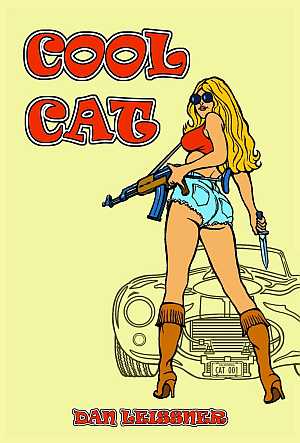
 My review of this is somewhat delayed, because the book spent two months inside what remained of our car, after a nasty accident on the freeway. It was finally rescued, and the next chance I got was actually on a plane going to Las Vegas – fortunately, it appears as though the book was not cursed, and I survived that trip intact. Chris actually got to read this one first: she made note of Leissner’s frequent usage of the word “Undulating”, to describe everything from the landscape to the heroine’s figure. Me? It’s a good word, one you don’t get to use too often, so more power to him there. The heroine in question is Cat Warburton, the semi-estranged daughter of an industrial tycoon, who works as a secret agent for an agency of uncertain origins. Her intended vacation goes awry, and she finds herself knee deep in a plot involving black militants, white supremacists and – this’d be a spoiler if it weren’t mentioned on the back cover – aliens from outer-space. She’ll need all her talents, if you know what I mean, and I think you do, to survive.
My review of this is somewhat delayed, because the book spent two months inside what remained of our car, after a nasty accident on the freeway. It was finally rescued, and the next chance I got was actually on a plane going to Las Vegas – fortunately, it appears as though the book was not cursed, and I survived that trip intact. Chris actually got to read this one first: she made note of Leissner’s frequent usage of the word “Undulating”, to describe everything from the landscape to the heroine’s figure. Me? It’s a good word, one you don’t get to use too often, so more power to him there. The heroine in question is Cat Warburton, the semi-estranged daughter of an industrial tycoon, who works as a secret agent for an agency of uncertain origins. Her intended vacation goes awry, and she finds herself knee deep in a plot involving black militants, white supremacists and – this’d be a spoiler if it weren’t mentioned on the back cover – aliens from outer-space. She’ll need all her talents, if you know what I mean, and I think you do, to survive.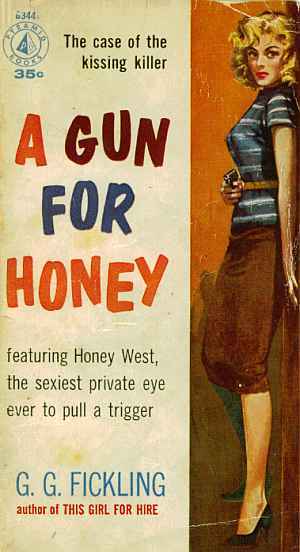 Honey West is best known as the heroine of a mid-60’s TV show created by Aaron Spelling, starring Anne Francis. But her origins actually date back almost a decade further, to a series of pulp detective novels written by Forest Fickling, under the vaguely-pseudonymic name of G.G.Fickling – his wife was Gloria, which may explain the choice. The heroine is a private eye, who follows her father into the profession, after he was killed on the job. These adventures, judging by A Gun for Honey, are rather more hard-boiled, and occasionally risque, than the TV show, though even in the book, the characters never actually seem to do “it”.
Honey West is best known as the heroine of a mid-60’s TV show created by Aaron Spelling, starring Anne Francis. But her origins actually date back almost a decade further, to a series of pulp detective novels written by Forest Fickling, under the vaguely-pseudonymic name of G.G.Fickling – his wife was Gloria, which may explain the choice. The heroine is a private eye, who follows her father into the profession, after he was killed on the job. These adventures, judging by A Gun for Honey, are rather more hard-boiled, and occasionally risque, than the TV show, though even in the book, the characters never actually seem to do “it”.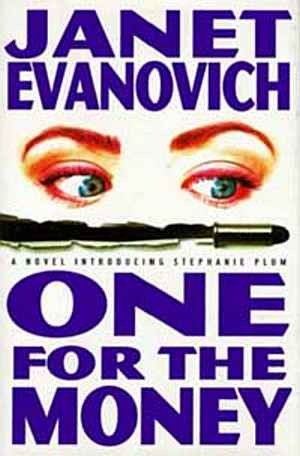 Former romance writer Evanovich switched genres and hit paydirt immediately with the first in the series, describing the adventures of former Newark lingerie buyer Stephanie Plum. She’s forced, through financial misadventure, to find a new job, and goes for a job filing paperwork for her bail bondsman cousin, but ends up hunting FTA’s (those who Failed To Appear for their court date) instead. She starts at the top, with suspended cop Joe Morelli, who has vanished after being accused of shooting an unarmed man. But as the witnesses to the incident start to die, Plum realises things may not be what they seem. The novice bounty huntress is well out of her depth, not least when she crosses psycho boxer Ramirez – until help comes from an unexpected source…
Former romance writer Evanovich switched genres and hit paydirt immediately with the first in the series, describing the adventures of former Newark lingerie buyer Stephanie Plum. She’s forced, through financial misadventure, to find a new job, and goes for a job filing paperwork for her bail bondsman cousin, but ends up hunting FTA’s (those who Failed To Appear for their court date) instead. She starts at the top, with suspended cop Joe Morelli, who has vanished after being accused of shooting an unarmed man. But as the witnesses to the incident start to die, Plum realises things may not be what they seem. The novice bounty huntress is well out of her depth, not least when she crosses psycho boxer Ramirez – until help comes from an unexpected source…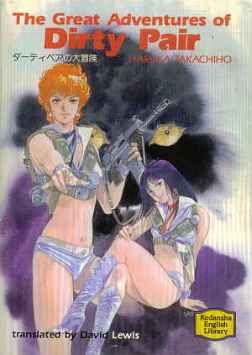 While in English, this came out in Japan, since it was part of a series of translations of popular works, intended as an aid for people learning the language. As a result, the book comes with translation notes at the back explaining, for example, what the phrase “We’re encased in a transparent sheathing of ultrathin reinforced polymer” means. Though I note the word “lesbian” is, apparently, deemed unworthy of further translation. It’s a swift read; discounting the notes, barely 125 pages long, and they’re not large pages either – a lunch-hour might suffice, if your boss gave you a few minutes grace.
While in English, this came out in Japan, since it was part of a series of translations of popular works, intended as an aid for people learning the language. As a result, the book comes with translation notes at the back explaining, for example, what the phrase “We’re encased in a transparent sheathing of ultrathin reinforced polymer” means. Though I note the word “lesbian” is, apparently, deemed unworthy of further translation. It’s a swift read; discounting the notes, barely 125 pages long, and they’re not large pages either – a lunch-hour might suffice, if your boss gave you a few minutes grace.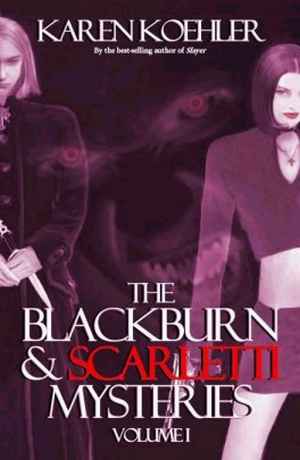 Take an FBI agent with some psychic ability, January Blackburn, and partner her with part-vampire Catholic priest, Dorian Scarletti. Intrigued? Me too. That’s the premise of the three stories in this book, where our odd couple investigate paranormal crimes around the US. The results are somewhat uneven, yet with much promise: Blackburn is probably a more interesting character, possessing both great inner strength, and quirks that make her vulnerable and more human. In contrast, Scarletti, thus far, seems a bit like a “vampire by numbers”, with all the standard moping around, relationship angst and so on, too familiar to be of more than passing interest. Though, must say, his weapon of choice – hundreds of cross-shaped throwing knives inside his coat – is worth cool points in my book (even if I presume he doesn’t go through airports).
Take an FBI agent with some psychic ability, January Blackburn, and partner her with part-vampire Catholic priest, Dorian Scarletti. Intrigued? Me too. That’s the premise of the three stories in this book, where our odd couple investigate paranormal crimes around the US. The results are somewhat uneven, yet with much promise: Blackburn is probably a more interesting character, possessing both great inner strength, and quirks that make her vulnerable and more human. In contrast, Scarletti, thus far, seems a bit like a “vampire by numbers”, with all the standard moping around, relationship angst and so on, too familiar to be of more than passing interest. Though, must say, his weapon of choice – hundreds of cross-shaped throwing knives inside his coat – is worth cool points in my book (even if I presume he doesn’t go through airports).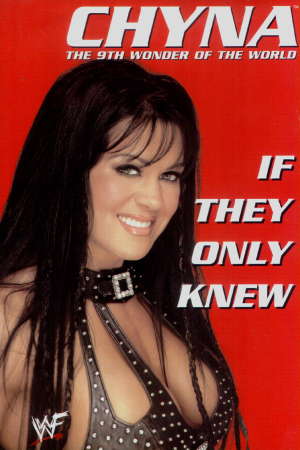 This is probably the first WWF bio from a wrestler who never won the world title. Yet Chyna made her mark, largely through her abandoning the T&A of the women’s division, to take on the likes of Triple H and Stone Cold. This would seem to be an interesting angle, from which to report. So why is the result so goddamn…well, whiny? Part of the problem is that any wrestle-bio has to compete with the genius which was Mick Foley’s first book, Have a Nice Day – for insight and sheer good humour, it’s almost impossible to beat. Yet that doesn’t mean you shouldn’t bother trying. Chyna, on the other hand, runs out little more than a “woe is me!” tale about what a horrible life she had, all the way from her childhood, up until the WWF plucked her from obscurity to make her a star.
This is probably the first WWF bio from a wrestler who never won the world title. Yet Chyna made her mark, largely through her abandoning the T&A of the women’s division, to take on the likes of Triple H and Stone Cold. This would seem to be an interesting angle, from which to report. So why is the result so goddamn…well, whiny? Part of the problem is that any wrestle-bio has to compete with the genius which was Mick Foley’s first book, Have a Nice Day – for insight and sheer good humour, it’s almost impossible to beat. Yet that doesn’t mean you shouldn’t bother trying. Chyna, on the other hand, runs out little more than a “woe is me!” tale about what a horrible life she had, all the way from her childhood, up until the WWF plucked her from obscurity to make her a star.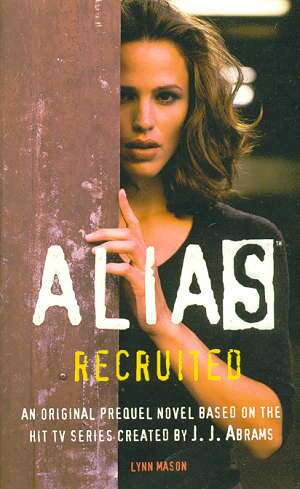 To tide you over the summer until the new series starts, as well as an ‘official companion’, Random House has published two novels, which fill in the back story before the show. Recruited tells of how Sydney Bristow was brought into SD-6, while A Secret Life details her first overseas mission, infiltrating a Paris fashion house being used as a cover for gun-running.
To tide you over the summer until the new series starts, as well as an ‘official companion’, Random House has published two novels, which fill in the back story before the show. Recruited tells of how Sydney Bristow was brought into SD-6, while A Secret Life details her first overseas mission, infiltrating a Paris fashion house being used as a cover for gun-running. This long-running series, with the 11th entry due in 2003, takes place in an alternative reality where vampires have equal rights as citizens. Heroine Anita Blake is a state-appointed executioner (“when good bloodsuckers…go bad…“) in St. Louis, who takes out the undead trash and also has a day job – actually, more of a night job – raising zombies. Oh, did I forget to mention them? There’s also were-creatures, ghouls, and pretty much the whole range of supernatural monsters.
This long-running series, with the 11th entry due in 2003, takes place in an alternative reality where vampires have equal rights as citizens. Heroine Anita Blake is a state-appointed executioner (“when good bloodsuckers…go bad…“) in St. Louis, who takes out the undead trash and also has a day job – actually, more of a night job – raising zombies. Oh, did I forget to mention them? There’s also were-creatures, ghouls, and pretty much the whole range of supernatural monsters. The above quote, from one essay in this collection of pieces on “violent women in the movies”, perhaps sums up its main problem. I cheerfully admit that my writing is skewed heavily towards the former point of view, but even so, too many of the authors here seem concerned with squeezing meanings out of films that were never intended to be there. This over-analytical approach results in the book swinging between thought-provoking and infuriating on almost every page.
The above quote, from one essay in this collection of pieces on “violent women in the movies”, perhaps sums up its main problem. I cheerfully admit that my writing is skewed heavily towards the former point of view, but even so, too many of the authors here seem concerned with squeezing meanings out of films that were never intended to be there. This over-analytical approach results in the book swinging between thought-provoking and infuriating on almost every page.